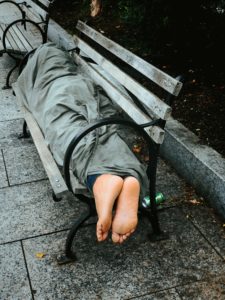The news is discouraging: We’ve been seeing an uptick in violence and behavioral issues in our schools. Recent data from the National Center for Education Statistics shows startling increases in conduct-related classroom disruptions, disrespect toward teachers and staff, rowdiness outside the classroom and detrimental effects on behavior development. What student red flags can teachers look for in terms of intervention so students can succeed in school?
SmartBrief’s recent Back-to-School 2022 SmartSummit covered social-emotional wellness and student success and offered answers to that question. Education Director Kanoe Namahoe talked with Rosemary Anderson, a licensed mental health practitioner who has worked in numerous settings including schools, courts and nonprofits. She’s passionate about integrating trauma-informed care and social emotional learning practices into our daily lives as a way to reduce stress.
This is Part 1 of our three-part coverage of the webinar. We’ve edited this Q&A for length and clarity. (Read Part 2 on classrooms and teachers and Part 3 on parent interactions, and view our other education articles or subscribe to our free newsletters.)
A rocky start to school?
SmartBrief: What pandemic-related mental and social-emotional issues should we be prepared to see this school year?
Anderson: I think what we’re seeing as practitioners in our communities are issues of anxiety-related disorders, particularly fear about how we were dealing with COVID and fear of violence in schools. We’ve had a lot of school shootings, and we’ve seen an uptick in fighting and bullying fueled by media conflicts. So the anxiety around even attending school is a very important point.
That leads me to social anxiety. What we’re seeing is students who have severe social anxiety, who want to remain in the virtual world. And then finally, depression, as well as a lack of motivation to even complete assignments or be reintegrated into academic environment.
Different issues for different students?
SmartBrief: That’s a difficult thing to hear. How are these issues affecting different populations of students?
Anderson: Well, I’m so glad you asked. I think it’s important, and I definitely want to highlight different constituency groups within the school community.

What we’re seeing with the gifted and talented, high-achievement population is performance anxiety, a lot of feelings of anxiety around perfectionism, and feeling that they want to make their parents happy around their academic performance. Yet, they they don’t have the networks they used to have. They don’t have the systems and the practices that they used pre-pandemic to help support them. And so they are feeling a high level of anxiety and expressing that.
In terms of urban and rural settings, we have not really come to grips with the fact that many of our families have experienced homelessness or some level of social-economic decrease because of joblessness. Lack of transportation also can be a concern that creates high anxiety, feelings of depression and feelings of dis-integration.
We have students with special needs who might have an individual education plan or a 504 plan, and their integration into school has been disrupted — whether the disruption of care of services, the delivery of those services, going virtual versus being in person and parents’ ability to actually access their providers and get the kind of continuity of support they would have normally have.
SmartBrief: Are we seeing more gifted and talented students that are anxiety-riddled over perfectionism?
Anderson: Yeah, what’s happened is that the systems of support they have been in schools — co-working in teams and teacher support — has been kind of disintegrated a little bit. Getting that back has been very important. So students that would have otherwise been supported in the cohort format — where they’re supported by other students, they’re in study groups, they’re actually networking, they’re getting after-school support — they haven’t been able to get that. Nor even talking at home with parents.
We have had kind of this idea of “OK, let’s just go back to normal, business as usual.” But our kids are actually telling us, “No, I don’t feel like everything is normal. And they want a forum to be able to talk about that.
Emotional and developmental student red flags
SmartBrief: Are there ways that educators and staff can identify if a student is struggling with their emotional or mental health? What are some of the signals, or student red flags? What are some of the situations they should look for?
Anderson: I think that what we have to do in terms of being a whole community is to look out for some key things. One would be looking out for the students that you remember were more outgoing and now they’re more introverted, or vice versa — someone that was more introverted is suddenly the polar opposite, more outgoing.
I’m thinking about a cohort of students that they are connected with: Has that changed or been modified?
Do you see a lack of motivation? Do you see physical signs of changes? Sleepy lethargy rather than disinterest?
Are there visual symptoms you see?
Are parents supporting students? Do you get the occasional email from the parent? Are the parents actually not integrated? That could be a red flag.
SmartBrief: What are the particular behaviors, or student red flags, associated with various ages? What should we be mindful, watchful of?
Anderson: At the elementary level, we see more of the physical manifestations: crying, isolating somewhere in the classroom, maybe poor attendance. Parental disengagement at the elementary level is a key sign — that lack of [Abraham] Maslow’s “Hierarchy of Needs.” So you have children coming dishelved or hungry or things like that.
In middle school, one of the premier themes I’ve been noticing is that disconnection from social groups. A huge preventive strategy for all the administrators and teachers is rebuilding classroom communities. You want kids to create unique cohorts of friends.
In middle school, developmentally, kids want to join groups. When you see students not joining groups, that is a telltale sign that something is happening in that — something that we cannot ignore. If we see students switching social groups suddenly, we need to be a little bit more probing.
Proactively, and reframing positively, we need to be the steward of creating nonhomogeneous groups in which students in the building can get to know one another based on their interests. If we can do that, we will then give a lot of young people who are silently hurting — particularly in sixth or seventh grade — we can give them hope that as they move on to high school.
Then in high school, what we see with students is lack of motivation, grades dropping, anger outbursts, disrespect, not coming to school at all and frequently failing.
Read parts 2 and 3 for complete coverage of the SmartSummit on Social-Emotional Wellness and Student Success. In Part 2, the conversation shifts to classrooms and teachers. In Part 3, Anderson shares her views on interactions with parents and creating a sense of community.
Diane Benson Harrington is an education writer at SmartBrief. Reach out to her via email, Twitter or LinkedIn.
______________________________
Subscribe to SmartBrief’s FREE email ASCD newsletter to see the latest hot topics in education. It’s among SmartBrief’s more than 250 industry-focused newsletters.
